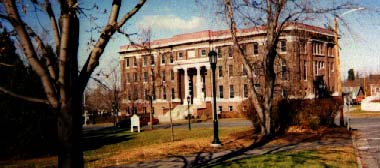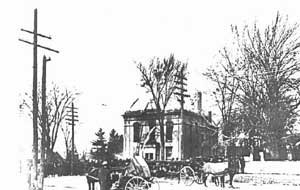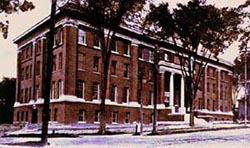

|
|
|
|
|
|
|
|
|
|

The present day Dewey Hall, home of the
Psychology Department of the University of Vermont, began as
the new Medical College of the University of Vermont.
Prior to 1904 the Medical College had
been housed at the same site in a building which burned in December
of 1903. 1 (A
photo of this tragic event, taken from the University Green,
is shown below. )
Unfortunately, the Medical College had fire insurance on the building only in the amount of $20,000. The estimate of $105,000 to build anew left a large gap between what the University had and what they would need to build the new space. The Trustees of the University, meeting in July of 1904, decided to ask the medical faculty to agree to pay the cost of a loan to be paid for ten years or until the University could afford to take over. Dean Trinkham of the Medical College duly convinced the faculty to do that. 2 Years later President Lyman Rowell gave credit to the citizens of Burlington for "raising among themselves a sum to be added to the funds pledged by the Faculty of the College of Medicine and others."3Regardless of the question of financing, the construction plans proceeded and the cornerstone was laid in July of 1904 at the Centennial Commencement. John Dewey, by then a famous alumnus, spoke at the ceremony, as did Dean Trinkham, Governor of Vermont McCullough and University President Buckham.4
The new Medical College building was designed by Burlington architect Walter R. B. Willcox. 5 Facing Colchester Avenue and the University Green, the building has a central pavilion containing the entranceway flanked by two-story two Ionic columns. Above the entrance, two square windows with criss-cross muntins flank a plaque that reads "University of Vermont College of Medicine 1825-1905."6 Other notable architectural features include the building's large rectangular brick mass with three stories above the water table and a full story below.
 Classes
began in September of 1905. In 1906 the entering class numbered
48 students. The whole matriculated class was 161 strong. Standards
for admission were stiffened in 1912 to require a year of academic
college and to lengthen the medical school year to equal that
of the academic year. Previously the school year for medical
studies had been seven and a half months.
Classes
began in September of 1905. In 1906 the entering class numbered
48 students. The whole matriculated class was 161 strong. Standards
for admission were stiffened in 1912 to require a year of academic
college and to lengthen the medical school year to equal that
of the academic year. Previously the school year for medical
studies had been seven and a half months.
The Medical College had always been given an A rating by the American Medical Association. However, in 1914 the Carnegie Institute made a study and issued a report that recommended closing down the University Medical College, as well as other medical colleges in Maine and Massachusetts. The fashion of the time called for large city schools such as those at Harvard and Yale. Fortunately for Vermont, the faculty, alumni, and the Vermont State Legislature decided to ignore the recommendation, reasoning that not many of the Harvard and Yale trained physicians would decide to settle in Vermont. The Legislature voted funding and the Medical College went on.7
By 1919 there was discussion at the Medical College regarding whether or not to admit women. There were already women in the Academic College, but the committee in charge of investigating the matter first got the opinion of a judge on the legality of the move; he said it was legal. In addition, the committee noted that other medical schools were including women. In 1920 they voted to admit women and in 1921 the first female student, Dorothy Lang, began classes. She was reportedly treated with reserve at first but by the time of graduation, she was second among the "honor" men and roundly cheered by her classmates.8
The Medical College continued to educate medical students although the building had to be shared with others. Between 1911 and 1941, the president and the administration of the university were housed on the main floor in front. President Guy Bailey was well suited to have students in the same building as his office. His main concern as president was the people of the University. During the Depression years he used school funds to pay faculty salaries and add to student scholarships. When President Bailey became ill and died in 1941 there was a problem for the University because of the misdirection of funds, but fortunately the University was able to raise more money and rebalance the budget. Eventually President Bailey was forgiven for using the funds to help students and faculty, probably at least in part because of the gratitude of the people he had helped.9
In 1941 the Waterman Building was erected and the president and the administrators moved out of the Medical College and into new building.10The move of the administration out of the Medical College gave much needed space to the school for their pathology, bacteriology, physiology, and pharmacology departments. The school kept teaching students through the nineteen fifties and sixties apparently unaffected in any substantial way for the Korean or Vietnam Wars. But as the years went by the need for more space to meet research and laboratory needs became clear.
By the 1960s it was apparent that the solution to the space problem was going to be a new medical college. The University decided to construct a Medical Science Center and turn over the Medical College Building to the Psychology Department, which by then had also grown quite large. The University Engineering Department did a feasibility study to determine if this was practical and what would be needed to make the change. In 1969 a contract between the Board of State Buildings and the Pizzagalli Construction Company of Burlington, Vermont , was signed at a cost of $1,131,000 for the project. 11
The Psychology Department put their ideas into the design and the city building code required certain other changes. The original entry and staircases were replaced and other features such as an elevator were added to make the building accessible to the handicapped. The original steeply pitched auditoriums were retained. 12 The exterior of the building is very much the same as it was in 1905, although the interior has changed. On completion of the renovations, the building was rededicated to John Dewey, alumnus of the University, who was born in Burlington and who had become world-renowned for his writings in psychology.13
Notes
1. Burlington Daily
Free Press. 3 December 1903. The Medical College
was housed in a residence which had been reconstructed for their
use by UVM benefactor John P Howard. The residence had
been built by Harry Bradley and later occupied by Levi Underwood
until Howard purchased it in 1884 . (return to
text)
2. University
Archives Notes of the Trustees Annual Meeting, July, 1904. (return to text)
3. Dedication Ceremony
Speech of September 10, 1969. Vermont Alumni Magazine,
November 6, 1969. (return to text)
4. UVM Green Exhibit,
University of Vermont Archives,1986.(return to
text)
5. University of Vermont
Land Records Office. Folder of Dewey Hall letters and plans
dated August 1904. Files of the Land Records Office of the University
of Vermont is an estimate by contractor George Mason who signed
a letter to the University estimating the cost of construction,
to include among other things "stone, terra cotta, iron
work, brick, hard pine floors and sky lights" would be $105,000.00.
He also wrote that he hoped the cost would be less than this
and that any time the University ran out of money that they could
halt construction. (return to text)
6. University Green
National Register Nomination, 1973. (return
to text)
7. William Chapin,
MD. Editor. History of the University of Vermont College of
Medicine. Dartmouth Printing Company. Hanover, New Hampshire.
1951. pp. 48-49.(return to text)
8. Ibid. p. 47.(return to text)
9. Jeffrey Marshall.
Universitas Viridis Montis. 1791-1955. University
of Vermont. 1991. (This particular president of UVM, Guy Bailey,
is spoken of with great warmth in my family because of his immediate
and voluntary assistance to my uncle when his mother died and
he was planning to quit school. My uncle remained in school
and finished his medical training in time to serve in WW II.)
(return to text)
10. Vermont Alumni
Magazine. May 6, 1940. p. 173.(return to text)
11. Vermont Land Records
Office contains a copy of the contract between the State Board
of Buildings and Remo Pizzigalli dated February 1969.(return
to text)
12. Vermont Land Records
Office contains an engineering report from the University of
Vermont Engineering Department, 1967.(return to
text)
13. Chapin, p. 49.
Fire, which has had such a major impact on cities and schools
everywhere, had great influence here at the University of
Vermont in relationship to the Medical College. Two different
medical buildings burned down in the early years and had a direct
impact on the design of the next two. An interesting story in
connection with the fire that burned the 1903 building is told
in the History of the Medical School and is confirmed by a fictionalized
account in the 1905 Ariel, the UVM yearbook. In the History
of the Medical School, one of the members of the class of 1906
related that two of his classmates were fooling around with a
pipe and a cigarette while waiting for the lecture to begin.
The coal from the pipe fell through a crack in the floor of the
amphitheater and started the fire; and thanks to a series of
other mishaps the fire department didn't get there in time to
be effective. The class had kept quiet about this and thought
that no one knew until Dr. Patrick McSweeny, on the occasion
of their fifth reunion, thanked the class of 1906 for the new
medical school. Today, with fire hoses in the halls and a lot
of fire resistant material used in the reconstruction one hopes
that there will be no more fires even when they do need more
space.